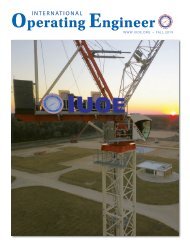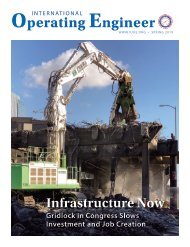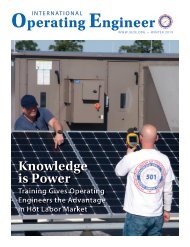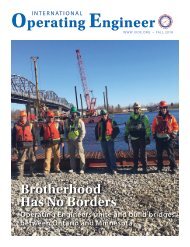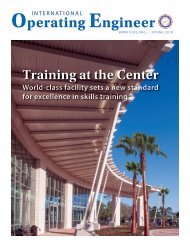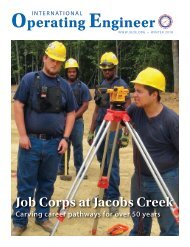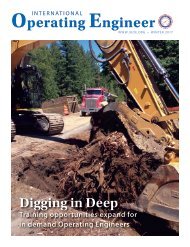125 Years Strong – An IUOE History
Celebrating the 125th Anniversary of the founding of the International Union of Operating Engineers
Celebrating the 125th Anniversary of the founding of the International Union of Operating Engineers
Create successful ePaper yourself
Turn your PDF publications into a flip-book with our unique Google optimized e-Paper software.
INTERNATIONAL UNION OF OPERATING ENGINEERS<br />
In the longer-term aftermath of the<br />
September 11, 2001, attacks, and<br />
recognizing the critical role operating<br />
engineers fulfill in such emergency<br />
situations, in July 2002 the union<br />
established the I.U.O.E. Homeland<br />
Security Division and the National<br />
Emergency Response Center in<br />
conjunction with the federal Office<br />
of Homeland Security. The center’s<br />
programs would prepare members<br />
to deal safely and effectively with<br />
emergencies as first-responders. In<br />
January 2004 during his address at the<br />
I.U.O.E. General Executive Board open<br />
session, National Homeland Security<br />
Secretary Tom Ridge recognized the<br />
I.U.O.E. for its role in homeland<br />
security, stating, “Our nation thanks<br />
you for your patriotism, your actions<br />
and your continuing commitment to<br />
homeland security.”<br />
More than two years earlier, shortly<br />
after “9/11” (as the attacks have become<br />
known) while he and the many other<br />
I.U.O.E. members were working on<br />
cleanup of the World Trade Center site,<br />
Brother Kenny Klemens of Local No.<br />
14, like so many other members, was<br />
adamant in his resolve:<br />
“The men who broke me in as<br />
an engineer built these towers. I<br />
feel it’s my duty to them and as an<br />
American to be here ... and as an<br />
operating engineer to help with the<br />
cleanup and to rebuild.”<br />
More Wins and More Goodwill<br />
With the events of 9/11 emblazoned<br />
into its collective spirit, the<br />
I.U.O.E. forged ahead and in<br />
early 2002 greatly expanded its organizing and<br />
political programs. By that time, it was deeply<br />
involved in leading the fight on a number of<br />
Members of I.U.O.E. Local No. 463 of Niagara Falls, New York, help rebuild<br />
the Prospect Point Observation Tower (or Niagara Falls Observation Tower)<br />
in Niagara Falls just east of the American Falls between 2001 and 2003.<br />
critical legislative issues that had the potential<br />
of creating hundreds of thousands of jobs in<br />
the construction industry and related services,<br />
the topmost of which were budget proposals on<br />
federal highway spending and a comprehensive<br />
energy bill.<br />
One particular effort alleviated a projected<br />
funding shortfall of $23 billion per year for<br />
investments needed over the coming 20 years<br />
to replace aging and failing pipes and to meet<br />
the mandates of the Clean Water Act and Safe<br />
Drinking Water Act. The I.U.O.E. joined the<br />
Water Infrastructure Network, a broad-based<br />
coalition of local elected officials, water-service<br />
providers, state environmental- and healthprogram<br />
administrators and engineers formed<br />
to encourage greater federal funding assistance<br />
to help preserve and protect the health,<br />
environmental and economic gains provided by<br />
the nation’s water and wastewater infrastructure.<br />
The following year during the I.U.O.E. 36 th<br />
General Convention held April 7 to 11 in Lake<br />
Buena Vista, 610 delegates again unanimously<br />
re-elected General President Hanley to another<br />
five-year term. They also ratified a number of<br />
constitutional amendments that included an<br />
increase in the per-capita tax from $7 to $7.75<br />
on July 1, 2003, and to $8.25 July 1, 2005 <strong>–</strong><br />
which would still be one of the lowest rates in<br />
the labor movement.<br />
The delegates also approved resolutions<br />
calling for increased participation in the<br />
political-legislative arena to support the passage<br />
of jobs-creating legislation such as investment<br />
in infrastructure projects, to protect Davis-<br />
Bacon prevailing wage laws, to oppose repeal<br />
or weakening of the Service Contract Act,<br />
and to oppose passage of any fast-track trade<br />
legislation lacking core labor and environmental<br />
protections. They further approved a measure<br />
Members of I.U.O.E. Local No. 148 of St. Louis working at the Joppa Power Station in southern Illinois in 2001.<br />
designating organizing as a priority interest of<br />
the I.U.O.E. and urging the union to “continue<br />
to pursue innovative programs and strategies to<br />
further its organizing efforts and to increase<br />
membership participation in those efforts.”<br />
Among the ongoing organizing victories<br />
gained by I.U.O.E. locals around the country,<br />
in 2004 Local No. 39 joined with Service<br />
Employees Local No. 1292 to organize over<br />
550 public-sector employees working for<br />
Tehama County, California, with the operating<br />
engineers representing 475 of the workers.<br />
Meanwhile, Local No. 18 of Cleveland,<br />
Ohio, secured a first contract for 210 workers<br />
at Ralston Foods in Lancaster, Ohio, with a<br />
four-year agreement that was ratified by an<br />
80-percent margin among the employees.<br />
General President Hanley retired on March<br />
1, 2005, and was succeeded by General<br />
Secretary-Treasurer Vincent J. Giblin after<br />
the General Executive Board voted for him<br />
to serve out the unexpired term, which would<br />
run until the next I.U.O.E. Convention in<br />
the spring of 2008. A 40-year member of the<br />
LABOR OMNIA VINCIT<br />
WORK CONQUERS ALL



